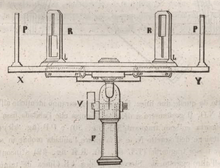Graphometer

The graphometer, semicircle or semicircumferentor is a surveying instrument used for angle measurements. It consists of a semicircular limb divided into 180 degrees and sometimes subdivided into minutes. The limb is subtended by the diameter with two sights at its ends. In the middle of the diameter a "box and needle" (compass) is fixed. On the same middle the alidade with two other sights is fitted. The device is mounted on a staff via a ball and socket joint. In effect the device is a half-circumferentor. For convenience, sometimes another half-circle from 180 to 360 degrees may be graduated in another line on the limb.[1]
The form was introduced in Philippe Danfrie's, Déclaration de l’usage du graphomètre (Paris, 1597) and the term "graphometer" was popular with French geodesists. The preferable English-language terms were semicircle or semicircumferentor. Some 19th-century graphometers had telescopic rather than open sights.[2]

Usage

To measure an angle, say, EKG, place the diameter middle C at the angle apex K using the plummet at point C of the instrument. Align the diameter with leg KE of the angle using the sights at the ends of the diameter. Align the alidade with the leg KG using another pair of sights, and read the angle off the limb as marked by the alidade. Further uses of the graphometer are the same as those of the circumferentor.[1]
References
- 1 2
 This article incorporates text from a publication now in the public domain: Chambers, Ephraim, ed. (1728). "Graphometer". Cyclopædia, or an Universal Dictionary of Arts and Sciences (first ed.). James and John Knapton, et al.
Pages: vol. 1 p. 179 for "Graphometer", vol. 2 p. 50 for "Semi-Circle"
This article incorporates text from a publication now in the public domain: Chambers, Ephraim, ed. (1728). "Graphometer". Cyclopædia, or an Universal Dictionary of Arts and Sciences (first ed.). James and John Knapton, et al.
Pages: vol. 1 p. 179 for "Graphometer", vol. 2 p. 50 for "Semi-Circle" - ↑ J. A. Bennett, "The Divided Circle" (Oxford, 1987), pp. 49-50, as quoted in the "Graphometer" article of the Smithsonian
- Ralf Kern: Wissenschaftliche Instrumente in ihrer Zeit. Vom 15. – 19. Jahrhundert. Verlag der Buchhandlung Walther König 2010, ISBN 978-3-86560-772-0
| Wikimedia Commons has media related to Graphometers. |